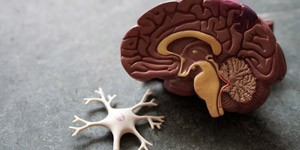By Carlos Goicoechea

Professor of Pharmacology at URJC. Ph.D. in Pharmacology from UCM. Coordinator of the "Research Excellence in Pain" Group at URJC- Santander (2014-2017), coordinator of the Pharmakom High Performance Experimental Pharmacology Research Group at URJC, and member of the Working Group on the Basic Science of Pain and Analgesia of the Spanish Pain Society (2018-2022). Director of the official Master's course "The Study and Treatment of Pain" (2007-2010). Vice-president of the Spanish Pain Society.
Author of 85 articles (of which 55 in international journals indexed by JCR), and researcher in 31 projects and 27 contracts (of which 15 as principal investigator). 122 participations in national congresses (of which 78 as invited speaker) and 113 in international congresses (of which 22 as invited speaker), 75 lectures given, 18 Doctoral Theses supervised (of which 3 "Extraordinary Doctorate Award"). 34 book chapters. 13 research awards (of which 2 international).
By Nuria Acero

Degree in Biological Sciences from the Complutense University of Madrid; PhD in Pharmacy from the Universidad CEU San Pablo; Professor of Pharmacognosy at the Universidad CEU San Pablo.
She teaches in the Area of Integrated Plant Physiology and is Coordinator of the Phytotherapy Module of the Master's Degree in Pharmaceutical Care at the Universidad CEU San Pablo and professor/tutor of the Online Master's Degree in Phytotherapy at UCH CEU.
She is responsible for quality and a member of the Internal Quality Subcommittee of the Doctoral Program in Health Science and Technology of the CEU International Doctoral School, and is attached to the Vice-Rector's Office for Faculty and Research.
As PI of the research group CEU-PRONAT, her multidisciplinary areas of research address the study of plants as a source of active ingredients of pharmacological interest.
She has completed four six-year research periods, is co-inventor of two national patents, and is a member of the Spanish Society of Phytotherapy and the European Society of Phytochemistry.
Recently, the Spanish parliament's Health and Consumer Commission has endorsed the regulation of medical cannabis in Spain. This is a pioneering initiative, both in terms of how it was carried out and due to the fact that the possibility of regulating the use of a plant rather than an active ingredient is being considered. One of the most frequently asked questions about cannabis and its medicinal use is whether it is preferable to use medicines made from the active ingredients of the plant or their synthetic derivatives, or to use the plant itself.
Cannabis is an annual herbaceous plant and it is dioecious, i.e. the male and female flowers are found on different plants. The part of the plant that is used therapeutically (and also in recreational use) are the female flowers, which are arranged in inflorescences located in the axils of the leaves. The female flowers are protected by bracts (modified leaves) on which a large number of hairs can be observed. The active principles are found in these hairs: chemical compounds responsible for the pharmacological activity of cannabis (Flores-Sanchez and Verpoorte, 2008). Chemically, we can highlight the presence of three types of molecules: Cannabinoids, Terpenes, and Flavonoids. Cannabinoids, and especially Tetrahydrocannabinol (THC), have been extensively studied since 1964. Other cannabinoids can also be found together with THC: Cannabidiol (CBD), Cannabigerol (CBG), Cannabidivarin (CBDV), or Tetrahydrocannabidivarin (THCV) (Russo, 2011). These appear in the plant in the form of acids that are transformed by heating or combustion into the aforementioned compounds, which are the ones that really impact on our organism. The amount or concentration of the various cannabinoids differs from one strain to another, but since THC Is the one that has a psychotropic effect, the levels of this compound in the strains used for recreational use have been increasing over the last 30 years. Is the same thing happening with medical Cannabis ? We will provide an answer later on.
Many diseases are multifactorial, which means that the activation of different receptors may be required to achieve a therapeutic effect. Plants and their extracts, possessing complex mixtures of active principles, can achieve this objective better than a single synthetic compound, as the components can act synergistically. (Whittle et al., 2001).
The presence of multiple compounds in the same plant has given rise to the development of a concept known generally as the "entourage effect", which refers to the possible synergistic effects between the different components (in this case cannabinoids) of the plant, allowing for the improvement of its therapeutic capacities with respect to the isolated components. In this case, the effect would cover both cannabinoid-cannabinoid interaction and cannabinoid-terpenoid or cannabinoid-phenol interactions.
Combining THC and CBD
The pharmacological effects of THC and CBD have been extensively studied. In short, THC has been shown to have psychoactive, anti-inflammatory, anticancer, analgesic, muscle relaxant, neuro-antioxidant, antispasmodic, and bronchodilator effects. For its part, CBD exhibits anxiolytic, antiemetic, antipsychotic, antiarthritic, analgesic, anti-inflammatory, anticonvulsant, and immunomodulatory properties (Andre et al., 2016). So far in Spain we only have two drugs made with cannabinoids: one of them is made with a mixture of THC and CBD and is indicated for the treatment of spasticity and pain in patients with multiple sclerosis, and for the treatment of opiate-resistant pain; the other, with CBD only, is used mainly for the treatment of seizures and epilepsy in children, although its usefulness in the treatment of chronic pain is currently being studied. One of the major advantages of these drugs is that we can precisely control the concentrations (and dosage) of the active ingredient administered to the patient, something that is much more complicated if we work with the medicinal plant as a whole.
Despite the interesting therapeutic effects of THC, these are inevitably linked to undesirable side effects such as memory problems, attention problems, cognitive alterations, motor coordination difficulties, psychosis (including schizophrenia), tachycardia, hypertension, or xerostomia. However, it has been shown that the joint administration of THC and CBD allows the appearance of joint effects (synergistic and antagonistic), due to the entourage effect; this would allow CBD to reduce the adverse effects of the former, such as psychotic symptoms and cognitive impairment (Iseger and Bossong, 2015). Some studies, such as that of Johnson et al., (2010) add relevant data in this regard. These authors conducted a clinical trial comparing the efficacy of an extract with THC alone (2.7 mg/100 µL) and another with THC and CBD (2.7: 2.5 mg/100 µL) versus placebo in the treatment of pain in 177 patients with advanced cancer, showing that the mixture of the two cannabinoids achieved better efficacy and tolerability results than THC or placebo alone. These and other results point to a synergistic effect of both compounds, which would achieve a greater therapeutic effect, with lower doses than those required when the active ingredients are administered separately, and, therefore, with a lower incidence of side effects. In view of these data, it could be extrapolated that, likewise, the use of the plant as a therapeutic remedy, by providing both compounds (and many more), would result in a reduction of side effects and therefore a greater acceptance of the treatment by the patient (Wagner and Ulrich-Merzenich, 2009). In this sense, as mentioned, CBD would help to reduce side effects of THC such as anxiety, sedation, cognitive deficits, memory deficits, or hunger.
The optimal ratio of CBD and THC in the plant or in the drug varies according to the pathology to be studied and is even different depending on the patient. Despite all this, the required concentrations of THC in medicinal cannabis (<10%) are usually lower than those in recreational cannabis (<15%) (Romero-Sandoval et al., 2017; Wilsey et al., 2013). The combination of both active ingredients reduces side effects, but we can surmise that it also improves tolerability. There are several studies that support that CBD, and perhaps other cannabinoids present in the plant, can act synergistically with THC, enhancing its beneficial effects, improving its therapeutic capacity (via a multi-targeted effect), reducing adverse effects, and improving some pharmacokinetic aspects such as the solubility or bioavailability of its components and/or its metabolism (Klein et al., 2011; Russo and Guy, 2006).
Do terpenes contribute?
As mentioned above, the effects of isolated cannabinoids, as well as their synergistic effects, have been studied, and we can find abundant literature on the subject. However, apart from THC or CBD concentration, certain patients showed a preference for strains that had specific concentrations of some terpenes. Terpenes are molecules that also accumulate in the glandular hairs of the bracts of the female flowers and that, fundamentally, give the plant its smell and flavour. They are a fundamental component of essential cannabis oil, and more than 100 of these compounds have been identified in the plant (Brenneisen, 2007). The question that arises is whether this preference on the part of some patients is influenced only by these organoleptic characteristics of the plant, or whether there is really some type of therapeutic benefit associated with the presence of these molecules, both in quantity and variety. Today, we know that these compounds are also pharmacologically active and that, together with cannabinoids, they constitute the main secondary metabolites of cannabis, without forgetting phenols, which we will discuss later. Among the most abundant monoterpenes and sesquiterpenes we can mention: limonene, α-terpineol, camphene, linalool, camphor, α-pinene, β-pinene, β-caryophyllene, and myrcene (Fischedick et al., 2010). These compounds are not exclusive to cannabis and they are also found as part of the essential oil of other plants. Their pharmacological potential has been analysed through preclinical and clinical studies, either with isolated terpenes or through essential oils with high concentrations of some of these compounds. For example, in laboratory animal studies, limonene showed anxiolytic, analgesic, anti-inflammatory, and antidepressant effects. This molecule contributes to muscle relaxation and aids sleep (Baron et al., 2018). β-pinene increased gastrointestinal motility, while α-pinene is an inhibitor of acetylcholinesterase and therefore could improve memory. Linalool showed analgesic, anticonvulsant, and anxiolytic activity, while myrcene showed anti-inflammatory, analgesic, and anxiolytic activity. Β-caryophyllene binds to CB2 receptors and displays anti-inflammatory and gastric protective activity (Andre et al., 2016). Therefore, terpenes show a multitude of pharmacological actions and, as there is a great variety of these compounds in cannabis, it cannot be ruled out that the aforementioned entourage effect, related to the synergy or antagonism of cannabinoids and terpenes, could explain the multi-target pharmacological effect. In addition, terpenes may also affect some pharmacokinetic aspects of THC, such as enhancing its bioavailability (the amount of substance reaching systemic circulation) through an increase in blood-brain barrier permeability (Smith, 2015), modulating the affinity of THC for the CB1 receptor, and interacting with receptors for certain neurotransmitters, which could explain how terpenes modulate the analgesic and psychotic effects mediated by cannabinoids (McPartland and Russo, 2001; Russo, 2011).
Let's not forget phenols
As for phenolic compounds, we can highlight the presence of different flavonoids, especially flavones and flavonols, such as apigenin, luteolin, kaempferol or quercetin, which are found both free and in the form of glycosides. In addition, there are two flavones exclusive to this plant: cannflavin A and B. Lignans and stilbenes are other phenols present in cannabis. Phenols in general are antioxidant compounds that help prevent numerous pathologies such as cardiovascular diseases, neurodegenerative diseases, or cancer (Andre et al., 2010, 2016). These types of molecules are not only able to scavenge free radicals, especially reactive oxygen species, but also modulate the levels of cellular antioxidant enzymes (Halliwell et al., 2005). Thus, for example, apigenin is anxiolytic, and together with other flavonoids present in cannabis shows a mild oestrogen effect, while, on the other hand, Cannflavin A is a potent inhibitor of prostaglandin E2 and of cyclo- and lipoxygenases, thus producing an interesting anti-inflammatory effect (McPartland and Russo, 2001).
Interactions of cannabinoids with other plant components
Scientific evidence of cannabinoid-terpenoid interaction is scarce. Information mostly comes from dispensaries extolling the virtues of patented chemical strains of cannabis, or chemovars. However, as we have seen above, some terpenoids have intrinsic physiological effects, so the idea of a combined effect should not be ruled out. In a survey of nearly 2000 patients using medicinal cannabis, those with migraine preferred strains with higher concentrations of β-caryophyllene and myrcene. This could reflect how the documented anti-inflammatory and analgesic properties of β-caryophyllene and β-myrcene could be coupled with the potent analgesic, anti-inflammatory, and antiemetic properties of THC (Baron et al., 2018). However, again we found contradictory results: in research conducted to analyse the contribution of terpenes and cannabinoids in cannabis-mediated analgesia in rats, which were intraperitoneally administered cannabis extract with and without terpenes, isolated terpenes, and Δ9-tetrahydrocannabinol (THC), no differences were found between rats treated with the whole extract and extract without terpenes, and it was further noted that the extract containing only terpenes was not active (Harris et al., 2019).
According to studies conducted by Santiago et al. (2019) in murine cell cultures transfected with cannabinoid receptors, none of the most abundant terpenes in cannabis can affect the interaction between THC and CB1 or CB2. This does not rule out the possibility of an entourage effect, since this interaction could occur by other means, such as acting on other proteins, affecting the metabolism and distribution of cannabinoids, interacting with G protein-coupled receptors, or with ligand-activated ion channels, among others. There are many other ways in which these molecules could interact with cannabinoids to influence the overall therapeutic and subjective outcomes of cannabis administration. We have reports of consumers with clear preferences for certain strains of cannabis, which could be explained by the entourage effect. However, these are personal experiences and we need scientific evidence.
Researchers agree that THC is the compound with the greatest therapeutic value, but the use of the plant as a whole can be equally valuable. More studies are needed because, for example, we do not know in what concentration terpenes reach the central nervous system and the brain when cannabis is consumed. Studies are needed in which different types of cannabis are analysed, with different concentrations of terpenes and phenols, since, for the most part, the effect of the sum is studied by simultaneously administering various previously isolated compounds. It is difficult to find works in which a pharmacological analysis of various types of cannabis is combined with an exhaustive phytochemical analysis of the samples used, which makes it difficult to extrapolate the findings to the consumers' habitual usage.
Do the effects of medical cannabis vary according to the modified varieties ("cultivars") and the manner of consumption?
The cannabis plants from which the various medicinal preparations are obtained can show important differences in the proportion of cannabinoids, but also of terpenes and/or phenols. The final composition may depend to a large extent on processing conditions, for example, the evaporation rate of some components during these steps. Many of the available medical cannabis preparations, especially oils, show lower amounts of terpenes (especially monoterpenes) than the plant (Eyalet al. 2022), while this amount remains higher when cannabis is consumed by smoking (Raz et al., 2022), which could explain the preference of some consumers for cigarettes or vapes versus oil (https://newfrontierdata.com/cannabis-consumers-in-america-2022/). To this should be added the fact that, given the existing legal situation, consumers (patients or otherwise) do not usually have a single source for the product, which makes it even more difficult to obtain reproducible effects.
The forms of consumption also influence the availability of the different components; for example, if Cannabis is vaped, terpenes are inhaled before cannabinoids (Eyalet al. 2022), although the impact that these differences in absorption may have on the pharmacological effect is still unknown.
On the other hand, in most of the studies, the composition of the different preparations of the plant is not detailed, being limited to expressions such as "Cannabis extract" or "Cannabis oil", which does not allow one to know the concentrations of the different components. Differences in processing and consumption methods make it extremely difficult to know, let alone predict, the importance of the effect of the various plant components on the final effect of medicinal cannabis. Therefore we could truthfully say that there is not a single entourage effect, but rather innumerable ones, depending on the presence and proportions of the various compounds due to the different forms of consumption.
In summary, the use of the cannabis plant allows the joint action of several of its components, which could reveal beneficial effects that have not yet been scientifically demonstrated. The cultivation of specific varieties under controlled conditions (humidity, temperature, soil, hours of light, etc.), together with standardised systems of extraction, purification, etc., would also allow products with stable concentrations of their different components. Thus, known and controlled compositions of terpenes, phenols, THC, CBD and other cannabinoids, as a whole, would give us the opportunity to profile more effective drugs, personalised for each patient's needs. Undoubtedly, taking advantage of the entourage effect would increase the pharmaceutical value of cannabis and justify the use of the plant over its isolated components.
Bibliography:
Andre, C., Larondelle, Y., Evers, D., 2010. Dietary Antioxidants and Oxidative Stress from a Human and Plant Perspective: A Review. Current Nutrition & Food Science 6, 2–12. https://doi.org/10.2174/157340110790909563
Andre, C.M., Hausman, J.-F., Guerriero, G., 2016. Cannabis sativa: The Plant of the Thousand and One Molecules. Frontiers in Plant Science 7. https://doi.org/10.3389/fpls.2016.00019
Baron, E.P., Lucas, P., Eades, J., Hogue, O., 2018. Patterns of medicinal cannabis use, strain analysis, and substitution effect among patients with migraine, headache, arthritis, and chronic pain in a medicinal cannabis cohort. The Journal of Headache and Pain 19, 37. https://doi.org/10.1186/s10194-018-0862-2
Brenneisen, R., 2007. Chemistry and Analysis of Phytocannabinoids and Other Cannabis Constituents, in: Marijuana and the Cannabinoids. Humana Press, Totowa, NJ, pp. 17–49. https://doi.org/10.1007/978-1-59259-947-9_2
Eyal AM, Berneman Zeitouni D, Tal D, Schlesinger D, Davidson EM, Raz N. Vapor Pressure, Vaping, and Corrections to Misconceptions Related to Medical Cannabis' Active Pharmaceutical Ingredients' Physical Properties and Compositions. Cannabis Cannabinoid Res. 2022. doi: 10.1089/can.2021.0173.
Fischedick, J.T., Hazekamp, A., Erkelens, T., Choi, Y.H., Verpoorte, R., 2010. Metabolic fingerprinting of Cannabis sativa L., cannabinoids and terpenoids for chemotaxonomic and drug standardization purposes. Phytochemistry 71, 2058–2073. https://doi.org/10.1016/j.phytochem.2010.10.001
Flores-Sanchez, I.J., Verpoorte, R., 2008. Secondary metabolism in cannabis. Phytochemistry Reviews 7, 615–639. https://doi.org/10.1007/s11101-008-9094-4
Halliwell, B., Rafter, J., Jenner, A., 2005. Health promotion by flavonoids, tocopherols, tocotrienols, and other phenols: direct or indirect effects? Antioxidant or not? The American Journal of Clinical Nutrition 81, 268S-276S. https://doi.org/10.1093/ajcn/81.1.268S
Harris, H.M., Rousseau, M.A., Wanas, A.S., Radwan, M.M., Caldwell, S., Sufka, K.J., ElSohly, M.A., 2019. Role of Cannabinoids and Terpenes in Cannabis-Mediated Analgesia in Rats. Cannabis and Cannabinoid Research 4, 177–182. https://doi.org/10.1089/can.2018.0054
Iseger, T.A., Bossong, M.G., 2015. A systematic review of the antipsychotic properties of cannabidiol in humans. Schizophrenia Research 162, 153–161. https://doi.org/10.1016/j.schres.2015.01.033
Johnson, J.R., Burnell-Nugent, M., Lossignol, D., Ganae-Motan, E.D., Potts, R., Fallon, M.T., 2010. Multicenter, Double-Blind, Randomized, Placebo-Controlled, Parallel-Group Study of the Efficacy, Safety, and Tolerability of THC:CBD Extract and THC Extract in Patients with Intractable Cancer-Related Pain. Journal of Pain and Symptom Management 39, 167–179. https://doi.org/10.1016/j.jpainsymman.2009.06.008
Klein, C., Karanges, E., Spiro, A., Wong, A., Spencer, J., Huynh, T., Gunasekaran, N., Karl, T., Long, L.E., Huang, X.-F., Liu, K., Arnold, J.C., McGregor, I.S., 2011. Cannabidiol potentiates Δ9-tetrahydrocannabinol (THC) behavioural effects and alters THC pharmacokinetics during acute and chronic treatment in adolescent rats. Psychopharmacology (Berl) 218, 443–457. https://doi.org/10.1007/s00213-011-2342-0
McPartland, J.M., Russo, E.B., 2001. Cannabis and Cannabis Extracts. Journal of Cannabis Therapeutics 1, 103–132. https://doi.org/10.1300/J175v01n03_08
Raz, N.; Eyal, A.M.; Davidson, E.M. Optimal Treatment with Cannabis Extracts Formulations Is Gained via Knowledge of Their Terpene Content and via Enrichment with Specifically Selected Monoterpenes and Monoterpenoids. Molecules 2022, 27, 6920. https://doi.org/10.3390/molecules27206920.
Romero-Sandoval, E.A., Kolano, A.L., Alvarado-Vázquez, P.A., 2017. Cannabis and Cannabinoids for Chronic Pain. Current Rheumatology Reports 19, 67. https://doi.org/10.1007/s11926-017-0693-1
Russo, E., Guy, G.W., 2006. A tale of two cannabinoids: The therapeutic rationale for combining tetrahydrocannabinol and cannabidiol. Medical Hypotheses 66, 234–246. https://doi.org/10.1016/j.mehy.2005.08.026
Russo, E.B., 2011. Taming THC: potential cannabis synergy and phytocannabinoid-terpenoid entourage effects. British Journal of Pharmacology 163, 1344–1364. https://doi.org/10.1111/j.1476-5381.2011.01238.x
Santiago, M., Sachdev, S., Arnold, J.C., McGregor, I.S., Connor, M., 2019. Absence of Entourage: Terpenoids Commonly Found in Cannabis sativa Do Not Modulate the Functional Activity of Δ 9 -THC at Human CB 1 and CB 2 Receptors. Cannabis and Cannabinoid Research 4, 165–176. https://doi.org/10.1089/can.2019.0016
Smith, N., 2015. Transdermal Cannabinoid Patch. 20,150,297,556.
Wagner, H., Ulrich-Merzenich, G., 2009. Synergy research: Approaching a new generation of phytopharmaceuticals. Phytomedicine 16, 97–110. https://doi.org/10.1016/j.phymed.2008.12.018
Whittle, B.A., Guy, G.W., Robson, P., 2001. Prospects for New Cannabis-Based Prescription Medicines. Journal of Cannabis Therapeutics 1, 183–205. https://doi.org/10.1300/J175v01n03_12
Wilsey, B., Marcotte, T., Deutsch, R., Gouaux, B., Sakai, S., Donaghe, H., 2013. Low-Dose Vaporized Cannabis Significantly Improves Neuropathic Pain. The Journal of Pain 14, 136–148. https://doi.org/10.1016/j.jpain.2012.10.009


